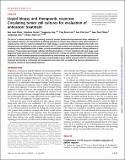Liquid biopsy and therapeutic response: Circulating tumor cell cultures for evaluation of anticancer treatment
Author(s)
Khoo, B. L.; Grenci, G.; Jing, T.; Lim, Y. B.; Lee, S. C.; Thiery, J. P.; Lim, C. T.; Han, Jongyoon; ... Show more Show less
DownloadKhoo-2016-Liquid biopsy and th.pdf (1.412Mb)
PUBLISHER_CC
Publisher with Creative Commons License
Creative Commons Attribution
Terms of use
Metadata
Show full item recordAbstract
The lack of a robust anticancer drug screening system to monitor patients during treatment delays realization of personalized treatment. We demonstrate an efficient approach to evaluate drug response using patient-derived circulating tumor cell (CTC) cultures obtained from liquid biopsy. Custom microfabricated tapered microwells were integrated with microfluidics to allow robust formation of CTC clusters without pre-enrichment and subsequent drug screening in situ. Rapid feedback after 2 weeks promotes immediate intervention upon detection of drug resistance or tolerance. The procedure was clinically validated with blood samples (n = 73) from 55 patients with early-stage, newly diagnosed, locally advanced, or refractory metastatic breast cancer. Twenty-four of these samples were used for drug evaluation. Cluster formation potential correlated inversely with increased drug concentration and therapeutic treatment. This new and robust liquid biopsy technique can potentially evaluate patient prognosis with CTC clusters during treatment and provide a noninvasive and inexpensive assessment that can guide drug discovery development or therapeutic choices for personalized treatment.
Date issued
2016-07Department
Massachusetts Institute of Technology. Department of Biological Engineering; Massachusetts Institute of Technology. Department of Electrical Engineering and Computer ScienceJournal
Science Advances
Publisher
American Association for the Advancement of Science (AAAS)
Citation
Khoo, B. L. et al. “Liquid Biopsy and Therapeutic Response: Circulating Tumor Cell Cultures for Evaluation of Anticancer Treatment.” Science Advances 2.7 (2016): e1600274–e1600274.
Version: Final published version
ISSN
2375-2548